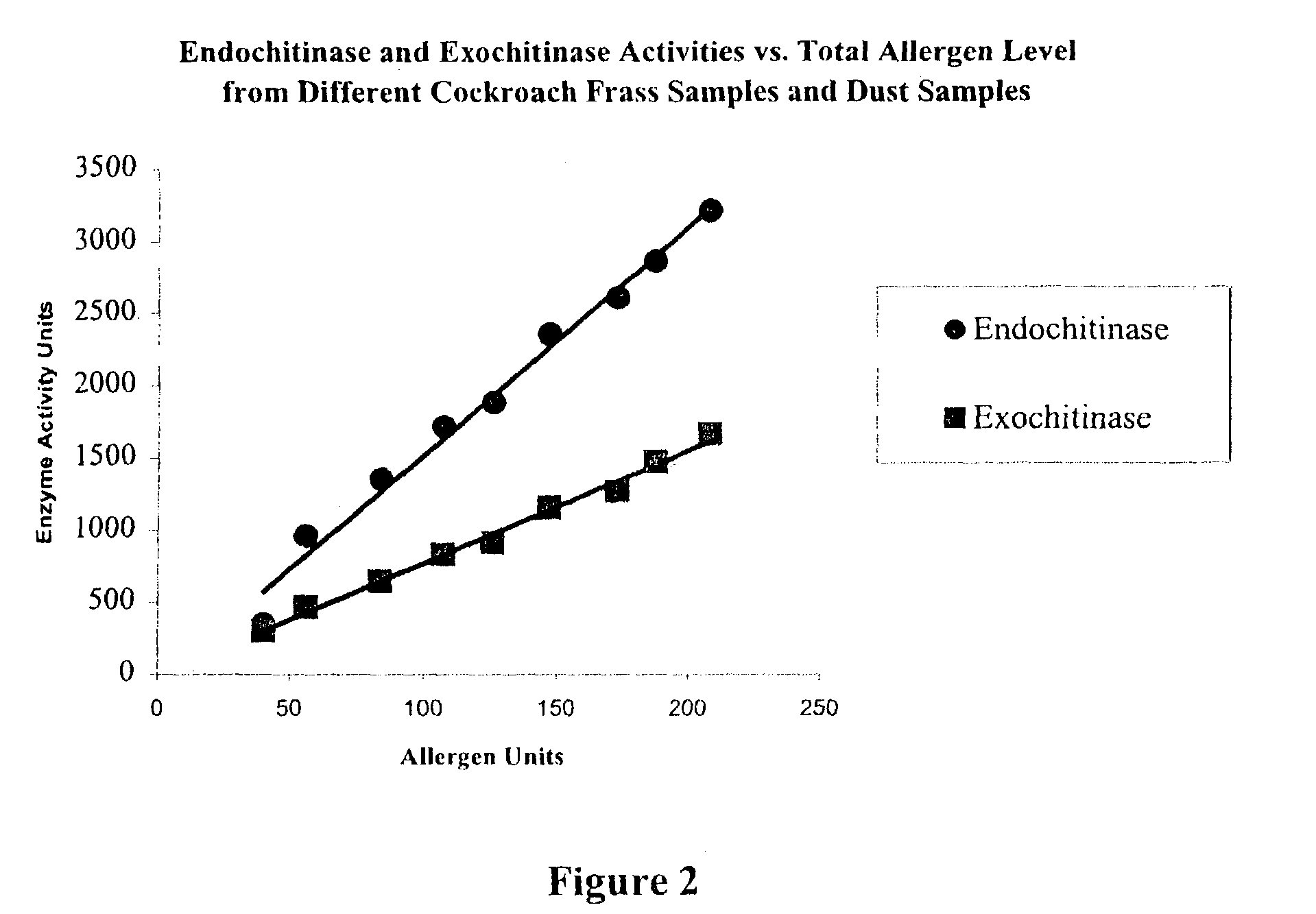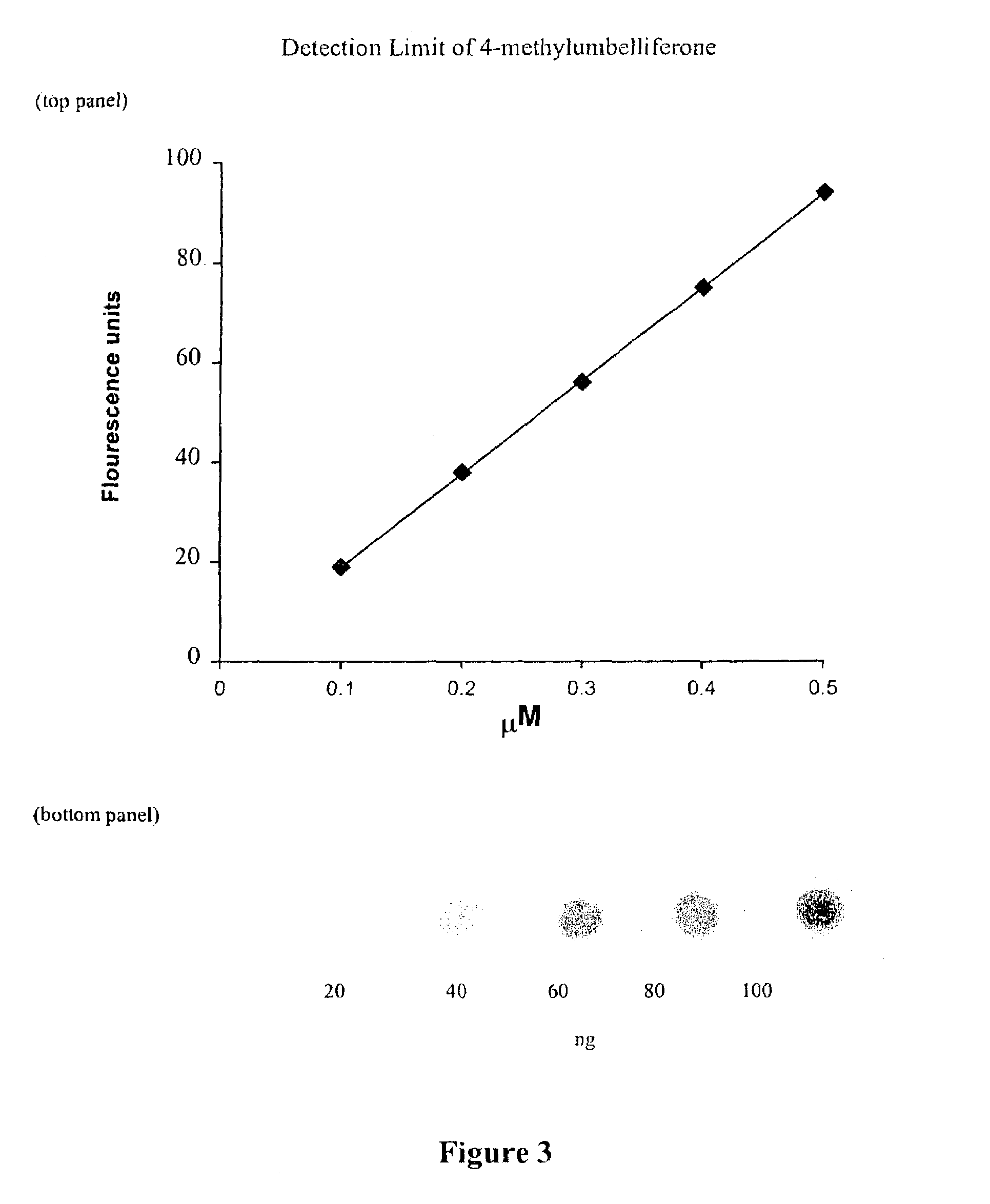Method for detecting cockroach allergens and determining total allergen level
a technology for allergen detection and allergen level, applied in the field of allergens, can solve the problems of recurrent episodes of coughing, wheezing, chest tightness, asthma, etc., and achieve the effect of reducing the incidence of allergic reactions or asthma
- Summary
- Abstract
- Description
- Claims
- Application Information
AI Technical Summary
Benefits of technology
Problems solved by technology
Method used
Image
Examples
example 1
Detection of Endochitinase and Exochitinase from Cockroach Frass Samples
[0049]A cockroach colony was maintained in a 120 gallon rectangular container with about 100,000 Germ an cockroaches. Eastern white pine wood shavings were placed at the bottom of the container where the cockroaches were. Pine wood boards were then staked on top of one other with ¼ inch thick spacers between them to allow 10 cockroach to nest between each set of boards. Dishes of food (laboratory chow) and water were placed on top of the pine wood boards. The containers were covered with cloth liners to prevent the escape of cockroaches.
[0050]Different frass samples of about 1.0 gram containing decayed dried dead body parts, fecal pellets, cuticles and egg cases, and secretions were collected from the bottom of the maintained cockroach colony. Frass extracts were prepared by homogenizing each frass sample in 5 ml of phosphate-buffered saline solution (PBS) at pH 7.4 followed by centrifugation at 13,000 g for 30 ...
example 2
The Stabilities of Endochitinase and Exochitinase to Heating and pHs
[0051]Cockroach allergens are known to be exceptionally stable. The stabilities of both endochitinase and exochitinase were determined at 100° C. and at different pHs. The June 1999 frass extract, as derived in EXAMPLE 1, containing both exochitinase and endochitinase was heated at 100° C. for 20 min. Either 4MU-(NAG)3 (for endochitinase) or 4MU-NAG (for exochitinase) substrate was added (final concentration of substrate was 1 μM) to react with the enzymes in the heated extract. The liberated fluorescence was measured using a Turner fluorometer with an excitation wavelength of 360 nm and an emission wavelength of 450 nm. A reading of one equals one activity unit. It was found that both heated enzymes retained full activity at 100° C. when compared to the unheated samples (results not shown). The stabilities of endochitinase and exochitinase were also determined at a pH range of 4.0 to 9.0. The extract retained full ...
example 3
Correlation of Endochitinase Activity with Total Allergen Level of Different Dust Samples
[0052]Dust samples of about 0.5 gram were collected from five different apartments and sieved with a 250 micron screen. Each of the sieved samples was extracted with 3 ml of 20 mM phosphate buffer (pH 7.0). Each extract containing the endochitinase was assayed in a final volume of 100 μl of 20 mM phosphate buffer (pH 7.0) containing 1 μM of 4MU-(NAG)3 substrate. After incubating at room temperature for 5 min., each of the reactions was stopped by adding 1 ml of 1.5 M glycine. The liberated fluorescence was measured using a Turner fluorometer as described in EXAMPLE 2. A control sample without the dust extract was also prepared. The reading from this control sample was minimal and was subtracted from the sample reading.
(a) Measurement of Total Allergens
[0053]The total allergen levels of the different dust samples were determined by directly spotting the extracts onto a nitrocellulose membrane. Th...
PUM
| Property | Measurement | Unit |
|---|---|---|
| Time | aaaaa | aaaaa |
| Mass | aaaaa | aaaaa |
| Mass | aaaaa | aaaaa |
Abstract
Description
Claims
Application Information
 Login to View More
Login to View More - R&D
- Intellectual Property
- Life Sciences
- Materials
- Tech Scout
- Unparalleled Data Quality
- Higher Quality Content
- 60% Fewer Hallucinations
Browse by: Latest US Patents, China's latest patents, Technical Efficacy Thesaurus, Application Domain, Technology Topic, Popular Technical Reports.
© 2025 PatSnap. All rights reserved.Legal|Privacy policy|Modern Slavery Act Transparency Statement|Sitemap|About US| Contact US: help@patsnap.com



